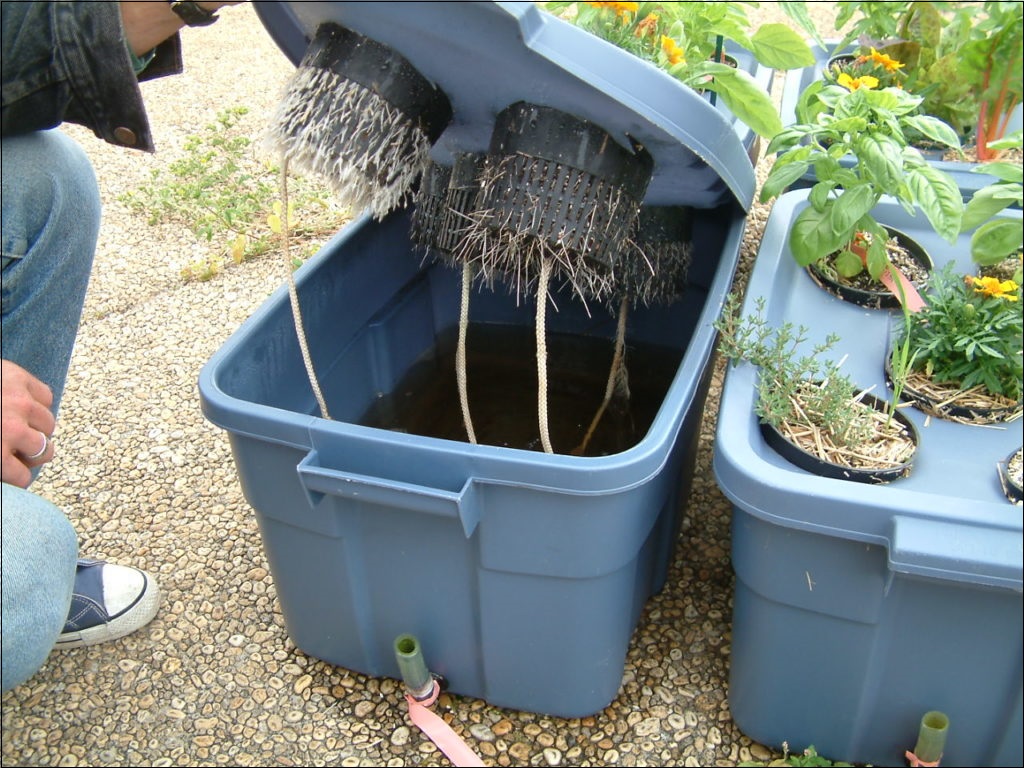Hydroponic Wick System, continued

A DIY wick system composed of a few plastic tubs, plants, pots, wicks and nutrient system. It doesn't get much simplier than this. Image courtesy of Architecture Lab.
You are on Page 2 of our six page series on hydroponic wick system section. Click on any of the below pages to jump to that page.
Page 1 Page 2 Page 3 Page 4 Page 5 Page 6
Disadvantages
The main disadvantage to the wick system is the speed at which the nutrient system can be delivered to the plant’s roots. For young plants, small plants and/or light feeding plants, wicking systems work well. This includes many greens such as leaf lettuce, mesclun, baby greens, small herbs and young seedlings. However, larger plants, hungrier plants and plants which need dry soils, or a wet/dry cycle, are not well suited to this system. Larger, hungrier plants simply can’t get nutrient solution fast enough via the wick system.
A second issue is that the growing medium is uniformly moist at all times. While some plants want or need uniformly moist soils, plants which need drier soils will struggle with root rot issues in this system.
A third disadvantage is that any given plant will draw up only the nutrients it needs at any given time, which may be less than what’s available. Over time, this can result in a build-up of excess nutrients in the growing media, which can in turn poison the plants. As a result, the growing containers must be flushed with fresh water at least once every two weeks to ensure that build-up is prevented.
Fourth, the nutrient system in the tank may become stratified, meaning that the nutrient salts begin to accumulate at the bottom of the tank, and thus aren’t available to the wick. This problem can be overcome by recirculating the nutrient solution in some way. That can be achieved by simply stirring the nutrient solution once or twice a day, by using a small pump, or by using something like an aquarium air stones or bubble wands. Stirring the solution by hand requires daily attention, while the latter solutions require power, both of which make the system a bit more complicated and/or expensive.
Another issue with the nutrient tank is that it must be kept dark, to ensure that algae doesn’t start to grow in the tank. This is usually accomplished by simply using a lid. By itself that’s not really a disadvantage, but it is a point that is sometimes overlooked during construction and then must be remedied after the fact. Once algae gets into a system, it’s very hard to get rid of. So this is a detail which is best addressed right from the start.
Finally, we must point out that a low-maintenance system is NOT the same as a no-maintenance system. For instance, if the nutrient solution reservoir gets low, such that the water level drops below the bottom of the wick, the wicking action will stop and the plants will dry out. Or if the plants are growing too quickly or too large and drawing nutrient solution relatively quickly, the wick may not be able to deliver new nutrient solution fast enough. Third, because the plants sometimes draw nutrients faster than the wick can provide, the plants themselves need to be monitored to ensure they are not developing nutrient deficiencies. We’ll cover all these details in later sections of this series. For now, just know that even this method does require monitoring.
You are on Page 2 of our six page series on hydroponic wick system section. Click on any of the below pages to jump to that page.